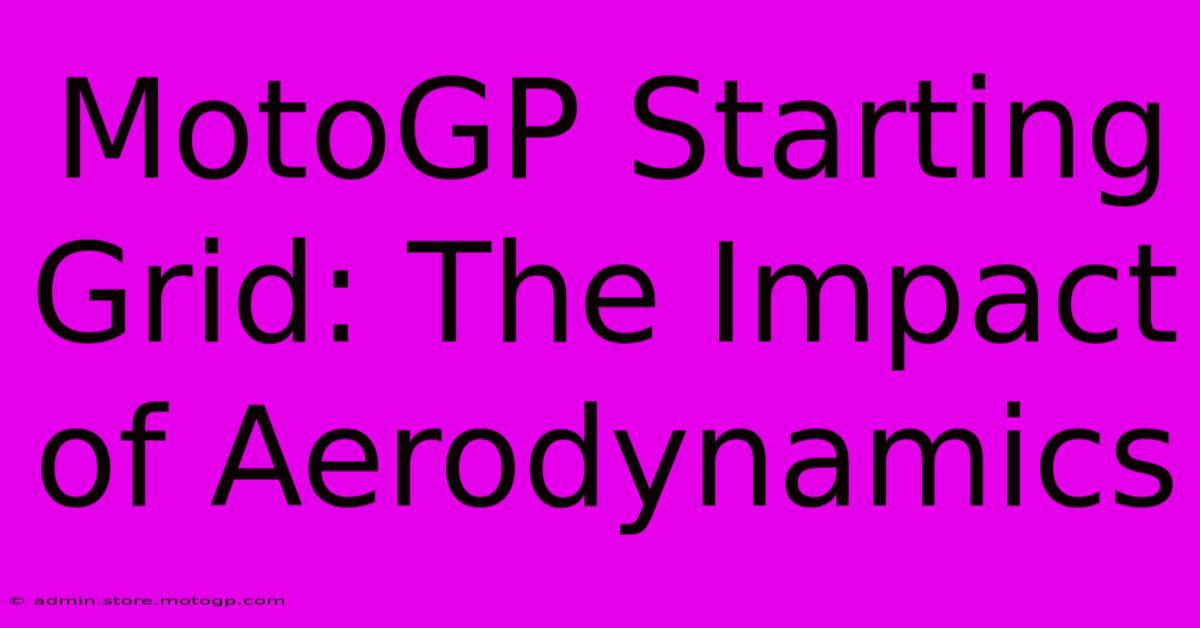MotoGP Starting Grid: The Impact Of Aerodynamics

Table of Contents
MotoGP Starting Grid: The Impact of Aerodynamics
The roar of the engines, the smell of burning rubber, the heart-stopping acceleration – MotoGP is a spectacle of speed and precision. But before the race even begins, a crucial battle is already underway: the fight for the perfect starting grid position. While rider skill and qualifying lap times are paramount, the often-overlooked factor influencing grid position is aerodynamics. Understanding how aerodynamic performance impacts starting grid placement is key to comprehending the complexities of MotoGP racing.
The Aerodynamic Arms Race
MotoGP bikes are marvels of engineering, and aerodynamic efficiency is a constant battleground. Teams invest heavily in wind tunnel testing and Computational Fluid Dynamics (CFD) simulations to refine every detail of their machines, seeking even the slightest advantage. These advancements directly impact qualifying performance and, consequently, starting grid position.
Downforce and Stability: The Key Players
Downforce, the force pushing the bike towards the track, is crucial for high-speed cornering. More downforce equals greater grip, allowing riders to carry more speed through turns and ultimately achieve faster lap times. However, excessive downforce can hinder acceleration and top speed on straights. The delicate balance between downforce and drag is a crucial aspect of aerodynamic design.
Drag, on the other hand, is the resistance a bike experiences as it moves through the air. Minimizing drag is essential for maximizing straight-line speed. Teams strive for a design that provides sufficient downforce for cornering without generating excessive drag that slows them down on the straights. This intricate relationship between downforce and drag significantly affects qualifying lap times, directly influencing starting positions.
Aerodynamic Components and Their Influence
Several key aerodynamic components play a significant role in a bike's performance and starting grid position:
1. Fairings and Bodywork:
The design of the fairings and bodywork significantly impacts airflow around the bike. Sophisticated shapes and meticulously placed air vents help manage airflow, minimizing drag and optimizing downforce distribution. Small changes to the fairing's design can result in significant improvements in lap times and starting grid positions.
2. Winglets and Aerodynamic Appendages:
These small, wing-like structures are strategically placed on the bike to generate downforce. Their design is constantly evolving, with teams experimenting with different shapes and configurations to maximize their effectiveness. The placement and angle of these winglets are crucial for optimizing downforce while minimizing drag. A well-designed winglet package can provide a substantial advantage during qualifying.
3. Underbody Aerodynamics:
The airflow under the bike is just as critical as the airflow above it. Teams use carefully designed underbody components to manage airflow and generate downforce. Smooth surfaces and optimized airflow channels minimize drag and increase stability at high speeds. Improvements in underbody aerodynamics can lead to noticeable gains in lap times and ultimately better starting grid positions.
The Impact on Qualifying and the Starting Grid
The cumulative effect of all these aerodynamic components directly influences a rider's ability to achieve a fast qualifying lap. A bike with superior aerodynamics allows riders to carry more speed through corners, brake later, and accelerate harder out of turns. This translates to faster lap times and a coveted position on the starting grid. A front-row start can be the difference between victory and a mid-pack finish.
Conclusion: Aerodynamics - A Silent Competitor
While the riders and their skill take center stage in MotoGP, the unseen battle of aerodynamics plays a crucial role in determining starting grid positions. The relentless pursuit of aerodynamic efficiency pushes teams to the forefront of technological innovation, constantly seeking marginal gains that can determine the difference between triumph and defeat. Understanding the impact of aerodynamics provides a deeper appreciation for the complex engineering and strategic elements behind the breathtaking spectacle of MotoGP.

Thank you for visiting our website wich cover about MotoGP Starting Grid: The Impact Of Aerodynamics. We hope the information provided has been useful to you. Feel free to contact us if you have any questions or need further assistance. See you next time and dont miss to bookmark.
Featured Posts
-
From Zero To Hero Cota Qualifying Edition
Feb 19, 2025
-
Experience Cota Like A Pro Park In Lot R
Feb 19, 2025
-
Yesterdays Grand Prix A Race To Remember
Feb 19, 2025
-
F1 Concert An Unforgettable Night Of Entertainment
Feb 19, 2025
-
Ride Like A Pro Race Ready Motorcycles Await
Feb 19, 2025
